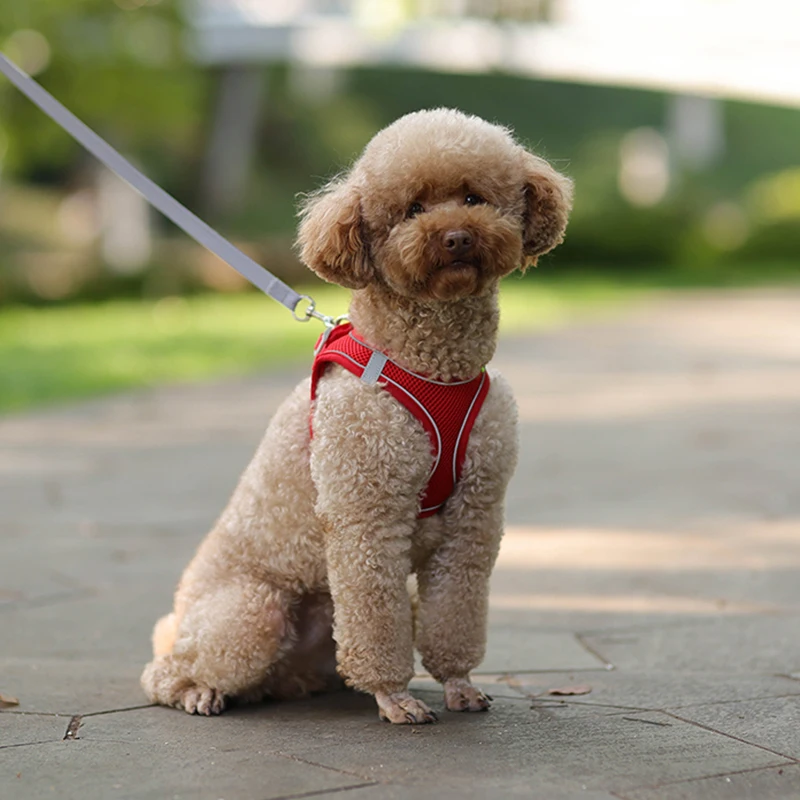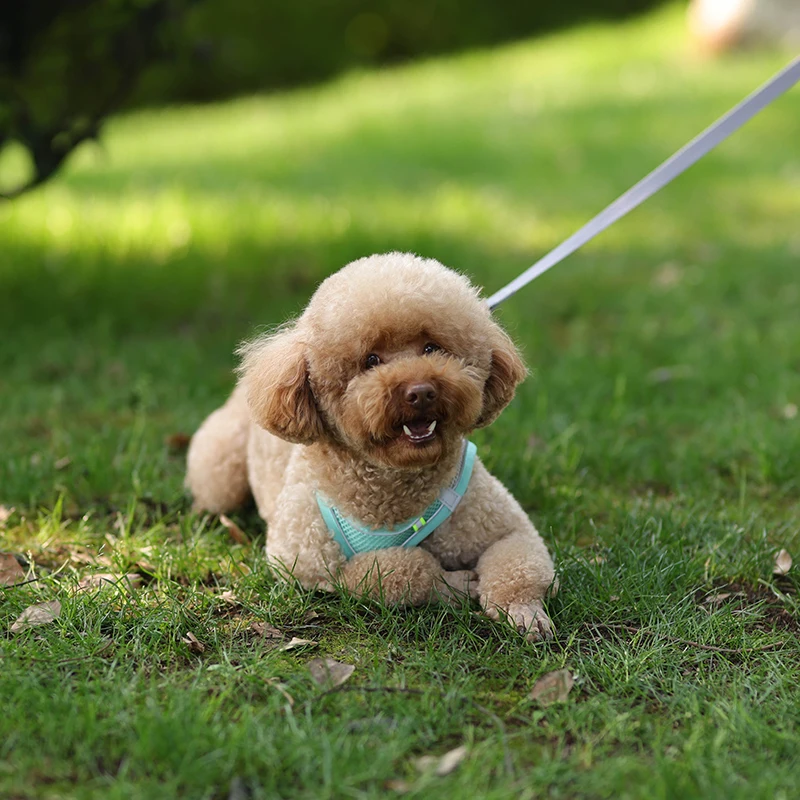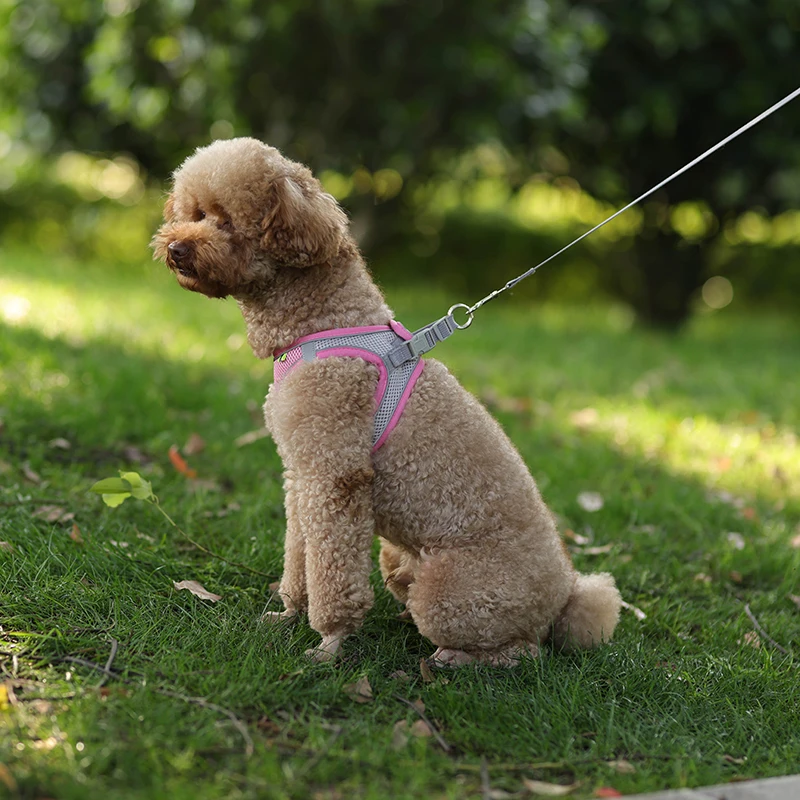The Importance of a Proper Fit for Small Dog Harnesses
Finding the right fit for a small dog harness is crucial. It’s not just about the look; it’s about your pet’s safety and comfort. A harness that fits well can prevent injuries and escape attempts. It also ensures that your dog is comfortable during walks, which is important for their well-being.

A proper fit means the harness is snug but not tight. It should allow two fingers to slide easily under any strap. The harness should not rub or cut into your dog’s skin or fur. It should not restrict movement or breathing.
Incorrectly fitted harnesses can lead to problems. A loose harness can get caught on objects, posing a danger. It can also make it easier for your pet to slip free and run away. On the other hand, a harness that’s too tight can cause chafing and discomfort. This can lead to skin issues or make your dog dislike walks.
To test a small dog harness’s fit, check it while your dog is standing and while moving. Watch for any signs of discomfort or restriction. Remember to adjust the fit as your dog grows or if their weight changes.
Ensuring a proper fit is the first step to keeping your small dog happy and safe on their adventures. When searching for the right small dog harness, always consult sizing charts and measure your dog accurately. Take your time to adjust the harness properly before heading out.
Various Types of Harnesses for Small Breeds
When selecting a small dog harness, it’s key to know the different types available. This knowledge ensures you find a harness that suits your pet’s size, personality, and lifestyle. Here we’ll explore the primary harness types designed for small breeds.
- Step-In Harness: As the name suggests, your dog steps into this harness, which then clips around the back. It’s easy to put on and ideal for calm dogs that don’t mind their paws being handled.
- Vest Harness: This style is more like a piece of clothing for your pet. It offers good coverage and can provide extra warmth, which small dogs often need. The vest harness is also good for dogs with sensitive skin since it distributes pressure more evenly.
- Adjustable Strap Harness: With straps that can be adjusted around the neck and chest, this harness type offers a custom fit. It’s versatile and can accommodate small dogs as they grow or gain/lose weight.
- Harness with a Front Clip: This design features a clip at the chest, allowing for more control over the direction your dog walks. It’s particularly useful for small dogs that might try to pull or lunge.
- Padded Harness: For added comfort, a padded harness is a great choice. The extra cushioning is perfect for small dogs with delicate bodies, and it prevents rubbing and chafing.
In choosing the right type of small dog harness, consider your dog’s comfort as the highest priority. Each style has its benefits, so think about your dog’s daily activities and any special needs they may have. This will guide you in selecting a harness that not only fits well but also enhances your dog’s walking experience. Remember, a properly fitted harness is vital, so make sure to measure your dog and refer to sizing charts before making a purchase.
Key Features to Look for When Choosing a Harness
When searching for the perfect small dog harness, certain features can make all the difference. Paying attention to these details will help ensure you select a harness that is both secure and comfortable for your pet. Here are key features to consider:
- Adjustability: A harness with adjustable straps provides a customized fit. Look for multiple points of adjustment to accommodate your dog’s unique shape.
- Material: The harness material should be strong yet comfortable. Soft, breathable fabrics like mesh or padded materials work well for small dogs. Avoid rough materials that could irritate their skin.
- Closure Type: Harnesses come with various closures, such as buckles or Velcro. Buckles typically offer more security, while Velcro can be easier to adjust. Choose one that you can easily handle and that feels secure.
- Reflective Elements: For those evening walks, reflective strips or stitching can make your dog more visible to drivers. This is a safety feature that should not be overlooked.
- D-Ring Placement: The placement of the D-ring for leash attachment can affect your control and your dog’s comfort. A back-clip may work well for calm dogs, while a front-clip can provide more control for pullers.
- Weight and Size: Ensure the harness is appropriate for your dog’s size and isn’t too heavy. Small dogs benefit from lightweight harnesses that won’t weigh them down.
- Ease of Cleaning: Small dogs can get messy, so a harness that’s easy to clean will save you time and effort. Look for machine-washable options or materials that wipe clean easily.
By considering these features when selecting a small dog harness, you will enhance your dog’s comfort and improve their safety during walks. Always measure your dog and consult the sizing charts of the harness brands to ensure the best fit. Remember, a well-chosen harness can make your walks more enjoyable for both you and your furry friend.

The Intersection of Comfort and Style in Dog Harness Design
When shopping for a small dog harness, you don’t have to choose between comfort and style. Today’s designs merge both elements, ensuring your furry friend looks great while feeling great too. The fashion industry for pets has evolved, and so have the expectations of pet parents. Comfortable materials are now paired with eye-catching prints and colors. Here’s what to consider for the perfect blend of comfort and style:
- Soft Fabrics: Choose harnesses made of soft fabrics like cotton or neoprene. Soft materials won’t rub against your dog’s skin and will ensure they’re comfortable on every walk.
- Attractive Patterns: Look for harnesses with fun patterns or stylish designs that reflect your dog’s personality. Whether it’s a classic plaid or a vibrant color, a stylish harness can make your dog stand out.
- Functional Details: Items like reflective trim not only add a touch of style but also keep your dog safe at night. Features that offer practicality and looks are a win-win.
- Overall Design: The harness should be designed with a dog’s body shape in mind. Even the most stylish harness is no good if it doesn’t fit right.
Remember, the functionality of a small dog harness should never be sacrificed for fashion. But fortunately, many brands have mastered combining both. This means you won’t have to overlook the joy of dressing up your pet in a trendy harness that matches their lively spirit. Always prioritize comfort to ensure your dog enjoys their walks, but don’t shy away from harnesses that also show off their style.
Step-by-Step Guide to Fitting Your Dog for a Harness
Fitting your small dog with a harness should be easy and quick. Here’s a simple guide.
- Measure Your Dog: Get a soft tape measure. Measure around your dog’s neck and chest. Write down these measurements. They are key for finding the right harness size.
- Choose the Right Harness: With your measurements in hand, pick a harness. Make sure it matches your dog’s size using sizing charts.
- Open the Harness: Lay the harness flat on the ground. Unbuckle all straps. This makes it easy for your dog to step in.
- Place Your Dog: Gently guide your dog to step into the harness loops. Take care to not rush. Keep it calm and positive.
- Secure the Harness: Lift the harness and clip it around your dog’s back. If it’s a vest, pull it over their head.
- Adjust the Straps: Start adjusting. The harness should be snug, but not too tight. Use the two-finger rule under the straps.
- Check for Fit and Comfort: Watch your dog walk around. Look for any rubbing or discomfort. The harness should not restrict movement.
- Repeat the Fit Check Regularly: Dogs grow and change. Check and readjust the fit often, especially after grooming.
By following these steps, you can ensure a good fit for your small dog harness. Remember to keep comfort in mind. If your dog shows any sign of discomfort, readjust the straps. Always be patient and give your dog time to get used to the new harness.
Top-Rated Small Dog Harnesses on the Market
When shopping for a small dog harness, top-rated options often mean assured quality and satisfaction. Here are some of the best small dog harnesses available on the market:
- The Comfort Fit Metric USA Small Dog Harness: It scores high for its soft, lightweight material and snug, adjustable fit. Perfect for daily walks without any chafing.
- Puppia Soft Dog Harness: Known for its breathable air-mesh fabric, this harness provides comfort and style. It’s also equipped with an adjustable chest belt.
- Ruffwear Front Range All-Day Adventure Harness: With four points of adjustability, it promises a perfect fit. The padded chest and belly panels ensure your dog’s comfort during long adventures.
- Kurgo Tru-Fit Smart Harness: This harness boasts five points of adjustment and includes a no-pull D-ring. It’s sturdy and great for training.
- Chai’s Choice Best Outdoor Adventure Dog Harness: Reflective material for safety, a durable handle for control, and padding for comfort make this a top pick.
Each of these harnesses has unique features tailored to small dogs. Look for adjustable straps, breathable materials, and a secure fit. It’s essential to consider your dog’s specific needs. You might need a lightweight harness for a tiny pup, or a no-pull feature for a dog who tries to lead the way.
Remember to keep the keywords [small dog harness] in mind as you search. Aim for a harness that balances comfort with style. It should be secure yet easy to put on and take off. Most importantly, your dog should feel at ease while wearing it. Be sure to check customer reviews for insights on fit and durability. This way, you can select a harness well-loved by other small dog owners.
Care and Maintenance Tips for Small Dog Harnesses
To extend the life of a small dog harness, proper care and maintenance are essential. Follow these tips:
- Regular Cleaning: Clean the harness regularly to remove dirt and odors. If it’s machine-washable, follow the manufacturer’s instructions. For others, use a gentle soap and warm water.
- Check for Damage: Before each use, inspect your harness for any signs of wear or damage. Look for frayed edges or torn straps that could compromise safety.
- Proper Storage: When not in use, store the harness in a cool, dry place away from direct sunlight. This helps prevent the material from degrading.
- Avoid Chemicals: Keep the harness away from harsh chemicals that can weaken the fabric or straps. These might be found in household cleaners or pest control products.
- Dry It Properly: Never store the harness while it’s damp. Always allow it to dry completely, away from direct heat, to prevent mold and mildew.
- Smooth Out Tangles: Untangle straps after washing and before storage. This keeps the harness in good shape and ready for the next use.
- Regular Fit Checks: As you maintain the harness, periodically check that it still fits your dog properly. Growth or weight change can affect fit.
By following these maintenance tips, you’ll ensure your small dog harness remains a safe, comfortable, and stylish accessory for your pet’s adventures.

Common Mistakes to Avoid When Using a Small Dog Harness
When using a small dog harness, some common mistakes could compromise your pet’s safety and comfort. To keep your furry friend happy and secure, here are a few missteps to avoid:
- Ignoring the Fit: Never guess your dog’s size. Always measure and refer to sizing charts to avoid a poor fit.
- Overlooking Adjustments: After putting on the harness, failing to adjust it can be harmful. Straps should be snug, allowing for a two-finger gap.
- Forgetting to Check Regularly: Dogs grow and their size changes. Regular fit checks are necessary to maintain comfort.
- Skipping the Break-In Period: Give your dog time to get used to a new harness. Don’t rush this process.
- Neglecting Safety Features: Features like reflective strips can save lives. Don’t ignore them.
- Choosing Style Over Substance: A cute harness is worthless if it’s not functional. Comfort and fit should always come first.
- Using a Damaged Harness: Inspect the harness for wear and tear. Using a damaged harness can be dangerous.
- Incorrect Washing: Follow care instructions for the harness material. Wrong washing methods can damage it.
By being mindful of these common mistakes, you ensure a better walking experience for your small dog. Always keep safety and comfort in the forefront when choosing and using a small dog harness.